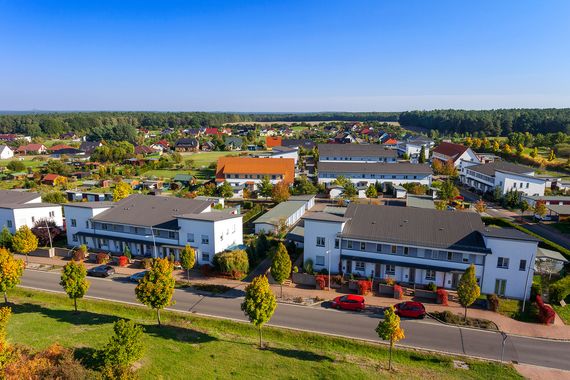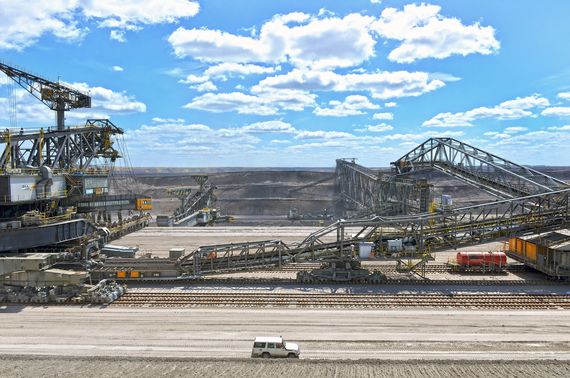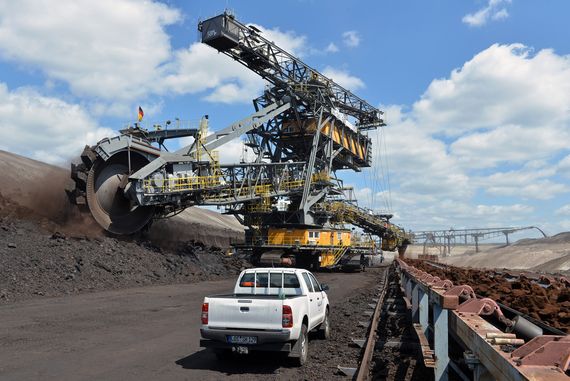Lusatian opencast mines
Our four Lusatian opencast mines, Jänschwalde and Welzow-Süd in Brandenburg as well as Nochten and Reichwalde in Saxony, are part of the Lausitz Energie Bergbau AG. The opencast mine Cottbus-Nord was closed according to plan in 2015. We are currently converting the area into a lake, the future Cottbuser Ostsee Lake.
Our Lusatian opencast mines supply our nearby power plants Jänschwalde, Schwarze Pumpe and Boxberg, as well as the Schwarze Pumpe refining plant. The haulage of the lignite is performed by our company's own central railway operation.
| Mining | Production Figures 2023 |
|---|---|
| Jänschwalde | 9.3 million tonnes |
| Welzow-Süd | 13.5 million tonnes |
| Nochten | 12.3 million tonnes |
| Reichwalde | 6.6 million tonnes |
How does an opencast mine function?
Lignite is only extracted in Germany in opencast mining. The process can be divided into four stages:
- 1. Preparing for mining
- 2. Removal of overburden
- 3. Extraction of the lignite
- 4. Redesign of the landscape
Preparing for mining
Work in an opencast mine starts with clearing of the excavation field and lowering the groundwater level. Forests have to be cleared and roads, railway lines or even rivers have to be re-routed. Sometimes it may also be necessary to resettle communities.
Water management
Pumping up the groundwater under the level of the lignite seam is a precondition for safe mining operations. We dewater only to the extent required for geotechnical safety. Each year about 2,700 filter wells around the opencast mines pump up approximately 340 million cubic metres of groundwater to the surface. About 70 percent is reintroduced into the local and regional water system. The remainder is mostly used in our power plants for steam generation or as cooling water. This avoids the extraction of additional water from rivers.
We operate seven pit water treatment plants. The groundwater, pumped up, is treated here. It is mostly iron that is removed, and the pH is adjusted to a more neutral value.
The lowering of the groundwater in order to mine lignite has the additional effect of lowering the groundwater in the surrounding areas, too, the so-called groundwater depression cone. Next to four of our Lusatian opencast mines underground sealing walls have already been constructed, to limit the lowering of the groundwater to the actual opencast mine and not to dewater neighbouring areas.
Resettling
In order to mine a lignite deposit, it is sometimes unavoidable that a community has to be resettled. For those affected, this is a clear break. Therefore, resettlements in the Lusatian mining district are guided by high standards in order to take the interest of the resettled citizens and municipalities into due account.
Removal of overburden
The term overburden is used to describe the thick layers of sand, gravel and clay that cover the lignite. In some places the seam is up to 120 metres deep. Overburden conveyor bridges of type F 60 carry away the overburden and expose the seam. Pre-cutting excavators work ahead of the bridge complex.
The opencast mine is spanned by the overburden conveyor bridge. This equipment complex removes the overburden – sand, gravel and clays – from above the lignite seam and transports it directly over the pit by the shortest route to the other side of the mine. Where the lignite has already been extracted, the overburden conveyor bridge deposits the soil. The opencast mine dump is created in this way.
Overburden conveyor bridges of the F60 type are able to remove, transport and dump approximately 60 metres thick overburden in a single operation. They are the largest mobile technical systems in the world with a total length of 500 to 670 metres and work at an average speed of nine metres per minute.
Pre-cutting excavators work ahead of the overburden conveyor bridge and extract the upper soil layers. The soil material is transported once around the opencast mine by means of belt conveyors. Deposited on the dump side as the uppermost layer, it forms the underlying basis for the design of the postmining landscape.
Extraction of the lignite
In the pit below the overburden conveyor bridge, bucket chain and bucket wheel excavators extract the raw lignite. Kilometre-long conveyor belts transport the raw material to the surface. The coal is transported to the power plants and the refining plant by belt conveyor or trains.
The deposits of lignite in the Lusatian mining district originated about 17 million years ago in locally different form. Characteristic is the horizontal orientation of the so-called lignite seams. We primarily extract the 2nd Lusatian lignite seam in opencast mines at a depth of about 60 to 120 metres.
This layer of lignite can be up to 15 metres thick – as high as a five-story building. The situation is different with the 1st Lusatian seam. It is also mined in the Nochten opencast mine between the process lines of the pre-cut and the F 60. On average it is about three metres thick.
Bucket wheel and bucket chain excavators convey the raw lignite, belt conveyors bring it out of the opencast pit. Overburden, for example, which accumulates as an intermediate layer in the lignite seam, is extracted separately and transported to the pre-dump of the F 60.
In 2023, 41.7 million tonnes of lignite were mined in the Lusatian mining district.
Environment and neighbourhood
Noise is produced when large machines are working in opencast mines, conveyor belts are running or trains are rolling. Even the whirling up of dust is not always avoidable, especially in dry weather. With a package of technical and organisational measures, we therefore endeavour to avoid or minimise the nuisance to the neighbouring communities of the opencast mines. Specialists support us by monitoring the noise and dust generated by opencast mining.
Measures to reduce the spreading of dust are for example sprayers and high pressure fogging systems as well as protective plantings on the edge of the mine and interim greening of the dump areas. With noise damping protective embankments, technical measures taken on the equipment and replacing acoustic signals with optical ones in the night shift we reduce background noise. All measures against noise and dust are monitored continuously and checked by the authorities responsible for approvals.
Further processing
Our opencast mines supply the LEAG power plants Jänschwalde, Boxberg and Schwarze Pumpe. In our refining plant, which is also located in Schwarze Pumpe, we also process selected raw lignite into modern fuels.
Recultivation
In parallel to lignite mining, the recultivation of the areas claimed takes place. The terrain is backfilled and shaped. The ground water rises again. New usable cultural landscapes are created here – both for forestry and agriculture as well as for nature conservation, leisure and recreation.
As a mining company we are obliged to reduce any interference with nature to the unavoidable minimum. The consequences of these interferences have to be compensated promptly, effectively and in a sustainable way. Thus, parallel to lignite mining activities recultivation work starts on the areas already mined-out. In order to ensure that the postmining landscape is stable even when the groundwater rerising is complete, the dumps are created on the basis of precise planning and expert assessments. If necessary, the soil is additionally compacted.
The aim of the subsequent recultivation is a diverse landscape typical of Lusatia and in harmony with the surrounding, which is utilisable on the long-term and ecologically valuable. Not a single tonne of lignite is mined without establishing ahead how the impact of mining on the existing cultural landscape can be balanced out. On what was an operational area previously there are now forests and agricultural land for future commercial use, habitats close to nature for animals and plants as well as water bodies.




